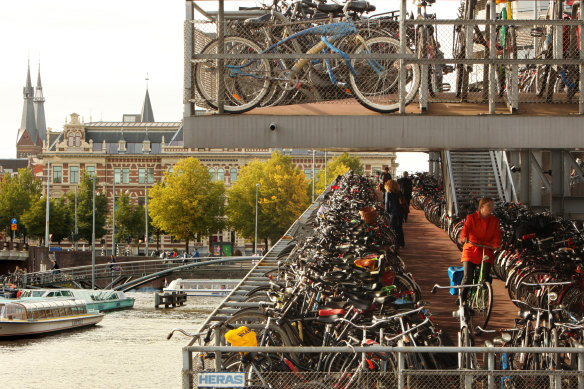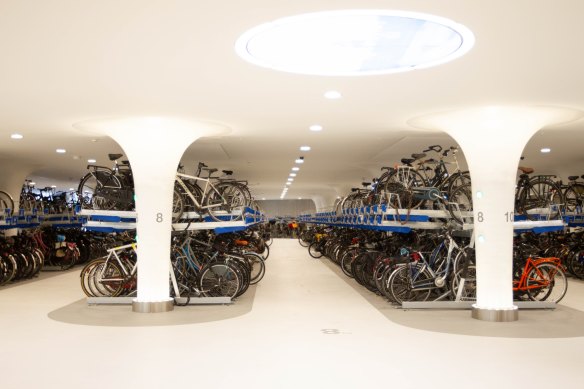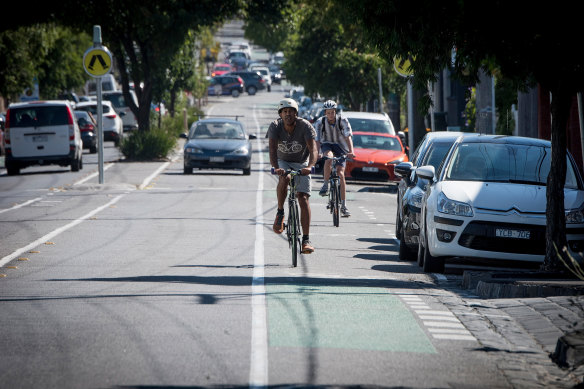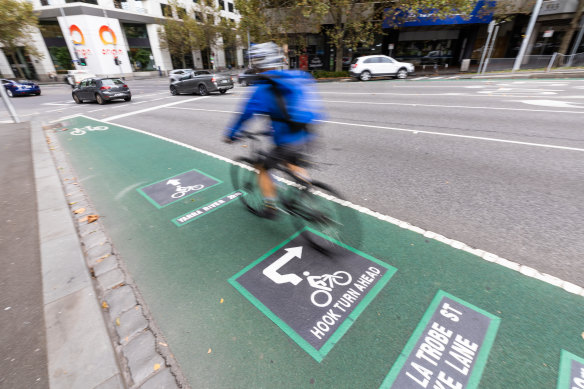No more helmets? Five lessons from the Dutch to get people cycling

Save articles for later
Add articles to your saved list and come back to them any time.
Key points
- The Netherlands has more bikes than people – with 1.3 bikes per person old enough to cycle.
- Cycling advocates in the Netherlands insist there are easy lessons from their experience that could be adopted in Melbourne.
- Bike parking garages at train stations have been key to encouraging commuters in the Netherlands to stop driving to work.
It’s rush hour in Amsterdam and the roads are full of people on bikes – not in cars – despite the constant drizzle.
The Netherlands is known as a cyclists’ paradise, with 37,000 kilometres of bike lanes – many separated from traffic.
A bike parking facility at Amsterdam Centraal train station.Credit: Penny Bradfield
It’s a country where there are more bicycles than people, with 1.3 bikes per person old enough to cycle.
This cycling nirvana is flat, densely populated and a long way from Melbourne, but policymakers and advocates in the Netherlands insist there are some easy takeaways that could be adopted here.
1. Bike parking at stations
Most train stations in Melbourne have a few rows of bike racks near the entrance.
Compare this to Utrecht train station, the busiest in the Netherlands, which has multi-storey parking for 30,000 bikes.
The bike garages operate like car parks with illuminated displays indicating the number of parking spots remaining on each level.
At the entrance to each bike garage is a repair shop and a rental service for train commuters to easily complete the last leg of their journey from the station to their destination.
Roland Kager, a mobility consultant and data analyst at Studio Bereikbaar in Rotterdam, said the number of people using trains in the Netherlands increased from 700,000 to 1.3 million pre-pandemic.
A new facility in Amsterdam using bike parking garages similar to those in Utrecht.Credit: Getty
“That has mostly been fuelled by more people reaching the station by bike,” Kager said. “So that’s roughly three-quarters of the surplus of train ridership, it’s attributable by more people going to stations and that’s mostly facilitated by bike park facilities.”
Kager said strong bike-to-train connections encouraged more people to cycle. An average of half of all train passengers travelled to the station by bike and 15 per cent used a bike at their destination, he said.
“I think this is a hidden component maybe of the success of the train in the Netherlands, but actually also the train is a hidden component of the success of the bike,” he said.
2. Lower speed limits
In Melbourne, a trial by the City of Yarra to cap speeds at 30km/h across suburban streets in Fitzroy and Collingwood was dismissed as “ridiculous” by Victoria Police Chief Commissioner Shane Patton last month.
The speed limit on 80 per cent of roads in Amsterdam was this week reduced permanently to 30km/h and the council expects up to 30 per cent fewer collisions as a result.
Researchers say the braking distance when a car is travelling at 50km/h is 27 metres, while it is more than halved to 13 metres when a car is travelling at 30km/h.
Town planners in the Netherlands also use raised stretches of pavement at the entrance to low speed zones and speed bumps to slow down traffic.
Cyclists riding along Wellington street in Collingwood where a 30 kilometre an hour speed limit is being trialled.Credit: Jesse Marlow
3. Ditch the helmet laws
Australia is one of the few countries in the world to mandate helmets while riding, but cycling advocates warn it discourages people from getting on a bike.
“Of course, when you put on protection it’s safer,” says Dutch senator Saskia Kluit. “But that’s actually not the most important question.
“If you get a little bit more safer – but a lot of people stop cycling or cycle less because of that – you will actually lose a lot of health impact and the health impact from cycling is immense.”
Kluit said based on the safety argument, people should wear helmets when they walk as well.
“Even when you walk it’s unsafe and wearing a helmet would be a good idea if you look at it scientifically,” she said.
4. Subsidies from private companies
In the Netherlands, private businesses have a role to play alongside government in encouraging bike use.
Businesses lobby for improved cycling infrastructure near workplaces, construct end-of-trip facilities and offer financial incentives to cycle.
Dutch employees can receive payment for riding a bike to work of €0.19 (31¢) per kilometre, a spend the government allows them to deduct from their tax bill.
“The benefit for the employer is that your employees are more healthy and more happy when they arrive,” Kluit says.
There are also employee incentives for buying a bike every three years.
Some of Melbourne’s dedicated bike lanes have caused backlash from residents.Credit: Jason South
5. Building local bike lanes
Dutch bike lanes, many of which are separated, are the envy of the cycling world, especially when compared to Australia’s cycle paths commonly demarcated from cars merely by lines of white paint on the side of the road.
About 60 per cent of Victorians are interested in cycling as a form of transport but are afraid to ride alongside traffic, state government surveys have found.
However, the construction of new bike lanes in Melbourne remains controversial. Local councils have removed bike lanes installed during the pandemic, and the City of Melbourne is pausing its bike-lane construction in the Hoddle grid after complaints from some traders and delivery drivers.
Kluit says rather than focusing on commuter bike routes and bike superhighways, one alternative could be building local, smaller bike infrastructure.
“What you very often see is that you have one bike lane, for example, and it’s being made an icon project for cycling and then it fails and then everybody’s very depressed,” she says. “One bike lane was never going to bring bike cycling culture to a city.
“If you start around schools and make safe walking and cycling routes to that school, then you build a community and then it’s much cheaper actually to make safe infrastructure in that small community than build a whole new separated bike lane somewhere.”
The reporter travelled to the Netherlands courtesy of Uber.
Get to the heart of what’s happening with climate change and the environment. Sign up for our fortnightly Environment newsletter.
Most Viewed in National
From our partners
Source: Read Full Article




